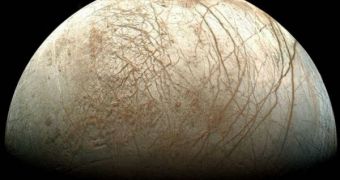Europa has been one of the favored targets in the solar system for experts looking for signs of life someplace else besides the Earth. Astronomers and astrobiologists have been drawn by the fact that the natural satellite features a smooth, craterless surface, an extended network of deep fractures, as well as a bright color. Together, these elements hint at the fact that an ocean of liquid water may still roam beneath the ices that make up the surface, and experts have wondered for a long time if oxygen can penetrate that deep. A new study suggests that it can, at a rate 100 times greater than first thought.
Previous researches suggested that, indeed, some oxygen reached the waters underneath Europa's surface. However, the new study appears to indicate that the earlier models were incomplete, and that the amount of oxygen penetrating the crust might, in fact, be 100 times larger. This is the equivalent of the moon being able to hold as much as three million tons of fish, if such creatures exist on Europa. In other words, it may be that the water holds sufficient amounts of oxygen to support not only basic life, but also more complex organisms, Wired reports.
According to the mathematical model created by University of Arizona in Tucson (UAT) expert Richard Greenberg, it may have taken between one and two billion years for oxygen to start penetrating the ice crusts above the ocean. The chemical may be generated as charged particles from the Sun collide with water molecules in the ices, chemists believe. UAT scientist Jonathan Lunine, who has not taken part in the new research, argues that this delay may have, in fact, been very important for allowing small organisms to develop.
Otherwise, he says, if oxygen had seeped through immediately, primitive bacteria or microbes (or their equivalents) wouldn't have had time to adapt to using the chemical, and would have been killed. The finds were presented on October 9 at the annual meeting of the American Astronomical Society’s Division for Planetary Sciences. Greenberg estimates that, although the moon itself is about 4.56 billion years old, having formed in the early days of the solar system, its surface crust is only 50 million years old, hinting at a dynamic process taking place underneath.

 14 DAY TRIAL //
14 DAY TRIAL //